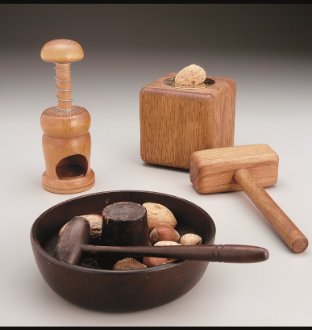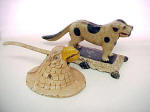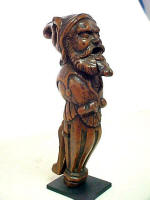




Nuts have been a significant part of the food supply since the beginning of time, and over the years, man has created ingenious ways to open the shells.
 Excavations
of early civilizations have revealed nutshells that were probably broken
by stones when too hard for the teeth to crack. Pitted stones used
for cracking nuts have been found in various parts of the United States
and Europe and have been dated back to the Archaic Period, 4,000 to
8,000 years ago. These nomadic peoples would camp near the nut
trees when it was time for the nuts to fall. Kernels were eaten
whole or ground to make flour or nut butters.
Excavations
of early civilizations have revealed nutshells that were probably broken
by stones when too hard for the teeth to crack. Pitted stones used
for cracking nuts have been found in various parts of the United States
and Europe and have been dated back to the Archaic Period, 4,000 to
8,000 years ago. These nomadic peoples would camp near the nut
trees when it was time for the nuts to fall. Kernels were eaten
whole or ground to make flour or nut butters.
 The
oldest known metal nutcracker dates to the third or fourth century B.C.
and is shown in a museum in Tarent, Italy. The Leavenworth
Nutcracker Museum shows a bronze Roman nutcracker dated between 200 B.C.
and 200 A.D. It was found in 1960 after being buried for over 1800
years.
The
oldest known metal nutcracker dates to the third or fourth century B.C.
and is shown in a museum in Tarent, Italy. The Leavenworth
Nutcracker Museum shows a bronze Roman nutcracker dated between 200 B.C.
and 200 A.D. It was found in 1960 after being buried for over 1800
years.
I ron
lever nutcrackers are shown in the Ironworks Museum in Rouen, France
with some dating back to the 13th
ron
lever nutcrackers are shown in the Ironworks Museum in Rouen, France
with some dating back to the 13th century,
and brass nutcrackers are known to have existed in the 14th and 15th
century. At first these metal nutcrackers were hand wrought, but
in later centuries, hot metals were poured into molds. England
became famous for its brass production and produced many nutcracker
styles, and the United States was known for its cast iron products.
century,
and brass nutcrackers are known to have existed in the 14th and 15th
century. At first these metal nutcrackers were hand wrought, but
in later centuries, hot metals were poured into molds. England
became famous for its brass production and produced many nutcracker
styles, and the United States was known for its cast iron products.
 The
first wooden nutcrackers were simply two pieces of wood fastened
together by a leather strap or metal hinge. By the 15th and 16th
century, wood carvers in France and England were creating beautiful
wooden nutcrackers. They used the wood from their locality,
but preferred boxwood because of its fine grain and uniform color.
Many of these delicately carved nutcrackers can be seen in the
Leavenworth Nutcracker Museum.
The
first wooden nutcrackers were simply two pieces of wood fastened
together by a leather strap or metal hinge. By the 15th and 16th
century, wood carvers in France and England were creating beautiful
wooden nutcrackers. They used the wood from their locality,
but preferred boxwood because of its fine grain and uniform color.
Many of these delicately carved nutcrackers can be seen in the
Leavenworth Nutcracker Museum.
|
|
Standing wooden nutcrackers in the form of soldiers and kings were shown in the Sonneberg and Erzgebirge regions of Germany by 1800 and in 1830, the term "Nussknacker" appeared in the dictionary of the Brothers Grim. It was defined as often in the form of a misshaped little man, in whose mouth the nut, by means of a leaver or screw, is cracked open. In 1872 Wilhelm Fuchtner, known as the father of the nutcracker, made the first commercial production of nutcrackers using the lathe to create many of the same design. The Leavenworth Nutcracker Museum shows an 1880 miner of Wilhelm Fuchtner along with a miner presently made in the Fuchtner family workshops. |
Many factors have contributed to the evolution of the nutcrackers form, functionality and character, the availability of materials, advances in production techniques, styles of the times, consumer demand, and even changes in the nuts themselves.
A study of nutcrackers is a study of history itself as they reflect the cultural values and innovations of the place and time of origin.
Open Daily 11-5
We suggest visitors arrive at least 30 minutes before closing.
"To foster and encourage the interest of the general public of the importance of nuts in the diets of humans throughout history and in the evolution of the nutcracker. No other tool or collectible has shown such a wide diversity of material and design as the implements used to crack the hard shell of a nut".